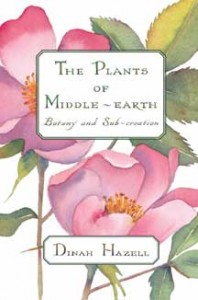
What a charming book!
Like The Unimaginable Mathematics of Borges’ Library of Babel, this was a find made in the American University library shelves. It stood out not only for the title (of all things it was sub-creation I was drawn to; the concept is Tolkien’s gift to the fantasy genre far more than any number of medieval worlds and elves) but also its soothingly soft green cloth binding with gold letters. Inside, it is gorgeously illustrated with drawings and watercolors of the planets, flowers, and trees discussed. The Unimaginable Mathematics of Borges… is a book you can put on your bookshelf to look intimidatingly smart; The Plants of Middle-Earth belongs on a coffee table or anywhere you’d like a guest to see it, pick it up, and feel welcome.
An unusual mixture of herb lore and literary criticism, Hazell’s book traces the significance of the plants featured throughout The Lord of the Rings and Tolkien’s related works. The history and myth surrounding plants can guide reader interpretation of the fictional events and cultures they appear in. The brief chapters were a pleasure to browse through on quiet evenings, studying the illustrations and learning the old names, uses, and superstitions of the herbs, flowers, and trees. The prose is simple but has a certain whimsical poetry that shares observations and the occasional new insight (I jotted down the line “roses escape commonality” to share with a friend who I associate with roses yet who is anything but common). I did not find the book particularly challenging or groundbreaking, although it had more texture than an ordinary book on botany and more real-world connections than most literary criticism.
I chose to say ‘real-world’ in the above paragraph advisedly; The Plants of Middle-Earth is less about the botany unique to Tolkien’s creation (though Hazell briefly discusses the possible inspirations of athelas and other fictional plants, including the Ents) and more about those shared with Earth and its own rich botanical traditions. This relates to the point Hazell wants to make about sub-creation: because the herbs, flowers, and trees which inhabit and form Middle Earth are familiar to us, we are willing to accept the otherwise unbelievable things that happen with them as a background. However, this potentially runs the risk of erasing an author’s work in creating his (or her) setting by over-reliance on what we know of the primary world. The folk magic that offers insight into the significance of Hobbit women’s names is based on the beliefs of medieval England, rather than anything Tolkien writes his Hobbits as believing. What if their superstitions about the Sweet Briar Rose are different? Does that matter, given real-world readers will form their impressions of a character named Eglantine based first and foremost on our own experiences and half-remembered knowledge? On a subject different from botany, Saruman the White’s choice of colors may be deceptive or ironic to Western readers familiar with white as the color of purity and goodness and black as the shade for corruption and evil, but I wonder if the turn his character takes would be less shocking to readers from cultures where white is the color of death and funerals.
As with The Unimaginable Mathematics, the target audiences for this work make up a Venn diagram: gardeners, folklorists, and Tolkien fans. Of course, there’s quite a bit of overlap (as there is, I suspect, between lovers of vast numbers, arcane mathematics fans, and Borges aficionados). I learned more about botany than Tolkien in reading it, and though it prompted some thinking about the role of environment in fiction and in the real world as well it is not by any means rigorous literary criticism; yet it sticks in my mind as a singularly unusual and enjoyable read.
Find It At: Goodreads Amazon Barnes and Noble Better World Books

 Therese Arkenberg's first short story was accepted for publication on January 2, 2008, and her second acceptance came a few hours later. Since then they haven't always been in such a rush, yet her work appears in places like Beneath Ceaseless Skies, Analog, Daily Science Fiction, and the anthology Sword & Sorceress XXIV. Aqua Vitae, her science fiction novella, was released by WolfSinger Publications in December 2011.
She works as a freelance editor and writer in Wisconsin, where she returned after a brief but unforgettable time in Washington, D.C. When she isn't reading, writing, or editing (it's true!) she serves on the board of the Plowshare Center of Waukesha, which works for social, economic, and environmental justice.
Therese Arkenberg's first short story was accepted for publication on January 2, 2008, and her second acceptance came a few hours later. Since then they haven't always been in such a rush, yet her work appears in places like Beneath Ceaseless Skies, Analog, Daily Science Fiction, and the anthology Sword & Sorceress XXIV. Aqua Vitae, her science fiction novella, was released by WolfSinger Publications in December 2011.
She works as a freelance editor and writer in Wisconsin, where she returned after a brief but unforgettable time in Washington, D.C. When she isn't reading, writing, or editing (it's true!) she serves on the board of the Plowshare Center of Waukesha, which works for social, economic, and environmental justice.